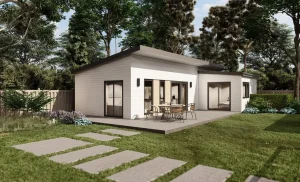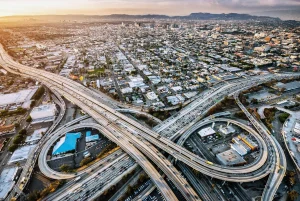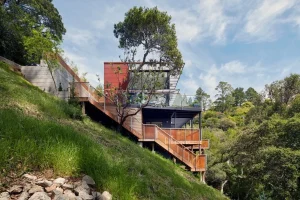The American Society of Civil Engineers publishes a report card known as the Report Card for America’s Infrastructure once every four years. It assigns letter grades to the nation’s infrastructure based on its physical condition and the investment required to make improvements. In it’s recent report it scored a C, and we have covered some of the sectors in detail below.
Bridges
The United States of America has around more than 617,000 different bridges. At this time, 42 percent of all bridges are at least 50 years old, and 46,154, which accounts for 7.5 percent of the nation’s bridges, are regarded as structurally deficient, meaning they are in “bad” condition. Unfortunately, 178 million vehicles make the hazardous journey across these bridges every single day despite their poor structural integrity. The United States requires a methodical program for the preservation of bridges, similar to the one adopted by several states, in which the maintenance of bridges to prevent further degradation is the primary concern.
The Rail Network
The rail network that serves our country can be broken down into two categories: passenger rail and freight rail. Freight’s Class I, II, and III railroads are responsible for operating around 140,000 rail miles of track. Amtrak runs over a network that is 21,400 miles long, of which 70 percent is owned by other railways and is hence referred to as a host track. There is still a significant gap between the difficulties encountered by passenger rail and freight rail, despite the fact that both types of rail travel are included in the same integrated system. The freight rail network in our country moved a total of 1.7 million ton-miles per day in 2018. This figure was recorded in 2018.
Roadways
Roadways in the United States are necessary to transport the ever-increasing number of people and products. Despite this, these essential lifelines typically receive insufficient funding, and as a result, over forty percent of the system is currently in poor or average condition.
Because there is a growing backlog of rehabilitation needs, drivers are forced to pay more than $1,000 annually for wasted time and fuel costs. In addition, even though the number of persons killed in car accidents has been decreasing, more than 36,000 people still lose their lives on the highways of the United States every year, and the number of pedestrians who are killed is rising. In addition to planning for the roadways of the future, which will need to take into account connected and autonomous vehicles, federal, state, and local governments will need to give priority to strategic investments that are dedicated to improving while also preserving the roadway conditions that increase public safety on the system that we currently have in place.
These improvements and preservation efforts increase public safety. Forty-three percent of our nation’s public roads are in either a bad or mediocre state of repair. It concerns that over the course of the past ten years, the percentage of vehicle miles traveled on roads deemed to be in “poor” condition has increased from 15 percent to more than 17 percent.
Schools
There are around 84,000 public schools in the United States, with nearly 100,000 buildings, and 56.8 million students are expected to be enrolled there by 2026. Public school buildings and facilities can be found in every municipality in the United States. Not only are they utilized as places of education, libraries, sports, and the provision of food for youngsters, but also as community meeting places, as well as centers and shelters for times of emergency. School buildings need to be in good condition to provide a safe and healthy environment for the kids that is conducive to learning for children of all ages. In addition to providing adequate spaces, natural light, working heating, and air conditioning, clean water, and modern technology to fulfill various other functions, school buildings also need to be in good condition.
Public transport
Public transportation makes access to employment, schools, shopping, healthcare, and other services possible, enabling fair access and sustainable mobility options. This makes public transit a crucial component of day-to-day life in communities all around the United States. Sadly, 45 percent of Americans do not have access to any form of public transportation. In the meantime, a large portion of the current operating system is getting on in years, and transit agencies frequently do not have adequate funding to keep their current operating systems in excellent functioning order. Nineteen percent of transit vehicles across the country were evaluated as being in “poor” condition over the course of a decade, while just 6 percent of fixed guideway features like tracks and tunnels received the same rating. The current backlog for public transportation is $176 billion, and it is anticipated that the shortfall will increase to more than $270 billion by the year 2029.
Port
Docks, piers, channel harbors, and other port facilities make up the port’s infrastructure. Conditions might differ from terminal to terminal, even within the same port, as a general rule. Despite this, it can be difficult for any port to keep its infrastructure in working order in the harsh sea climate. The rate of deterioration of everything from cranes to wharves is sped up by a variety of factors, including corrosion caused by seawater and deicing salts, frequent wet and dry cycles, temperature changes, and more. In these severe settings, port owners are responsible for ensuring that their infrastructure maintains its structural soundness.
Parks and Recreation
The average times a person in the United States goes to their community’s parks and other recreational facilities is more than twice a month. In 2017, consumers spent $887 billion on outdoor leisure, contributing directly to the maintenance of 7.6 million jobs. There are around ten acres of public park property for every thousand people who live there. Despite the rise in the popularity of parks, less money is being put into maintaining them, which has led to crumbling bridges, pathways, parking places, drinking water systems, and other aspects of park infrastructure.
Both state and local parks are facing a deferred maintenance backlog estimated to cost $5.6 billion and $60 billion, respectively.
As a result of the limited space available in urban areas, local governments, utilities, and nonprofit organizations are being forced to become more inventive in order to construct park projects that provide functions that are mutually beneficial to one another. One example of this would be public access spaces that also serve as flood control. Where the model destroys herself.
Superb Engineer is competent to provide engineering services for improving public infrastructure and has the specialized knowledge and abilities necessary to assist you in any situation!



